Web 2.0: Digital Portfolio and Critical Analysis Project Report
VerifiedAdded on 2020/10/05
|13
|3712
|405
Project
AI Summary
This assignment presents a comprehensive analysis of Web 2.0 technologies and their implications, encapsulated within a digital portfolio. The project begins with a reflective paper, followed by critical evaluations of two theoretical papers focusing on security threats and decision-making impacts, respectively. It also includes critiques of two white papers that discuss communication behaviors and strategic practices in a Web 2.0 world. A video post further explores the benefits, challenges, and future scope of Web 2.0 in a business context. The assignment also features three posts related to Web 2.0 and its business implications, showcasing the student's understanding of the topic. The student references multiple sources to support their analysis, demonstrating a solid grasp of the subject matter and the ability to synthesize information from various perspectives.
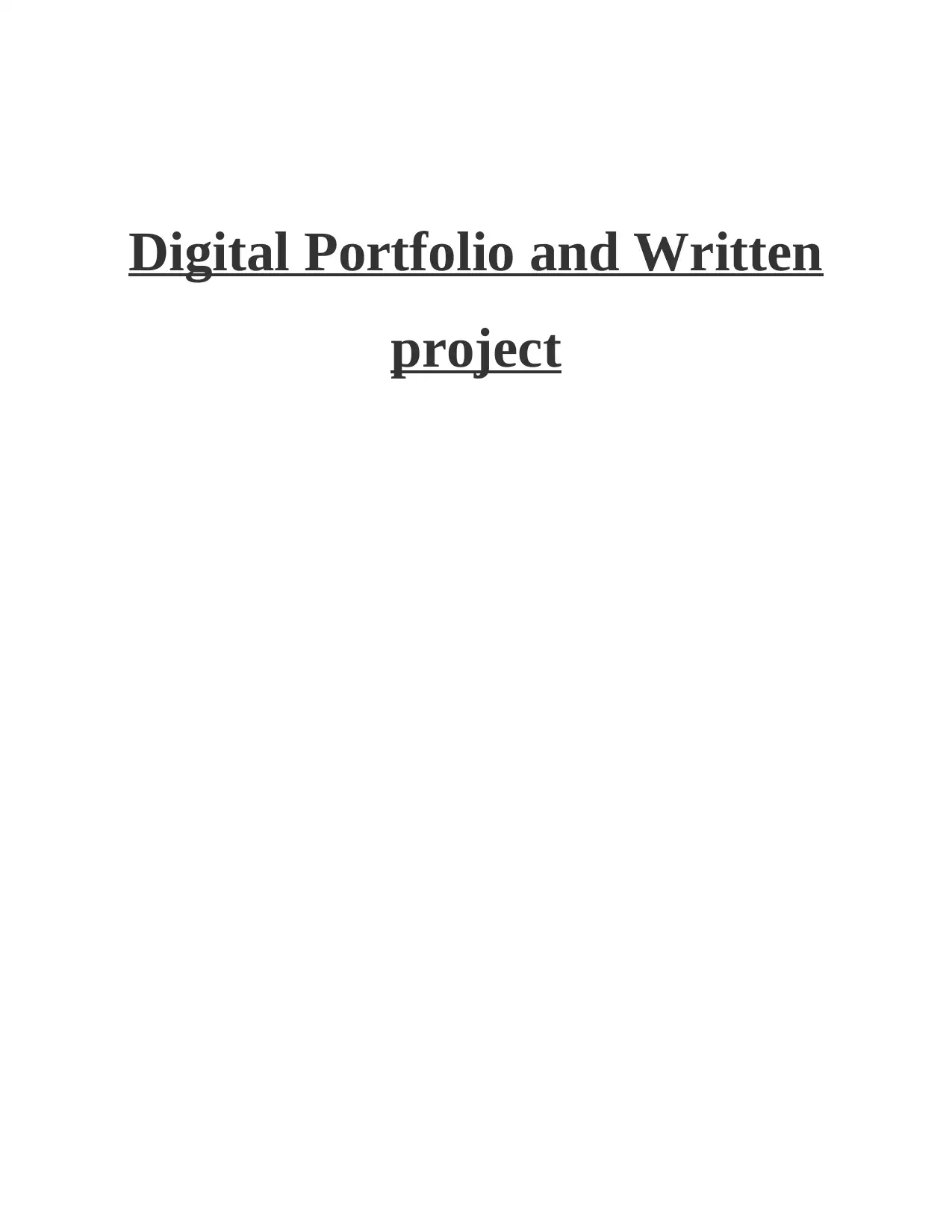
Digital Portfolio and Written
project
project
Paraphrase This Document
Need a fresh take? Get an instant paraphrase of this document with our AI Paraphraser
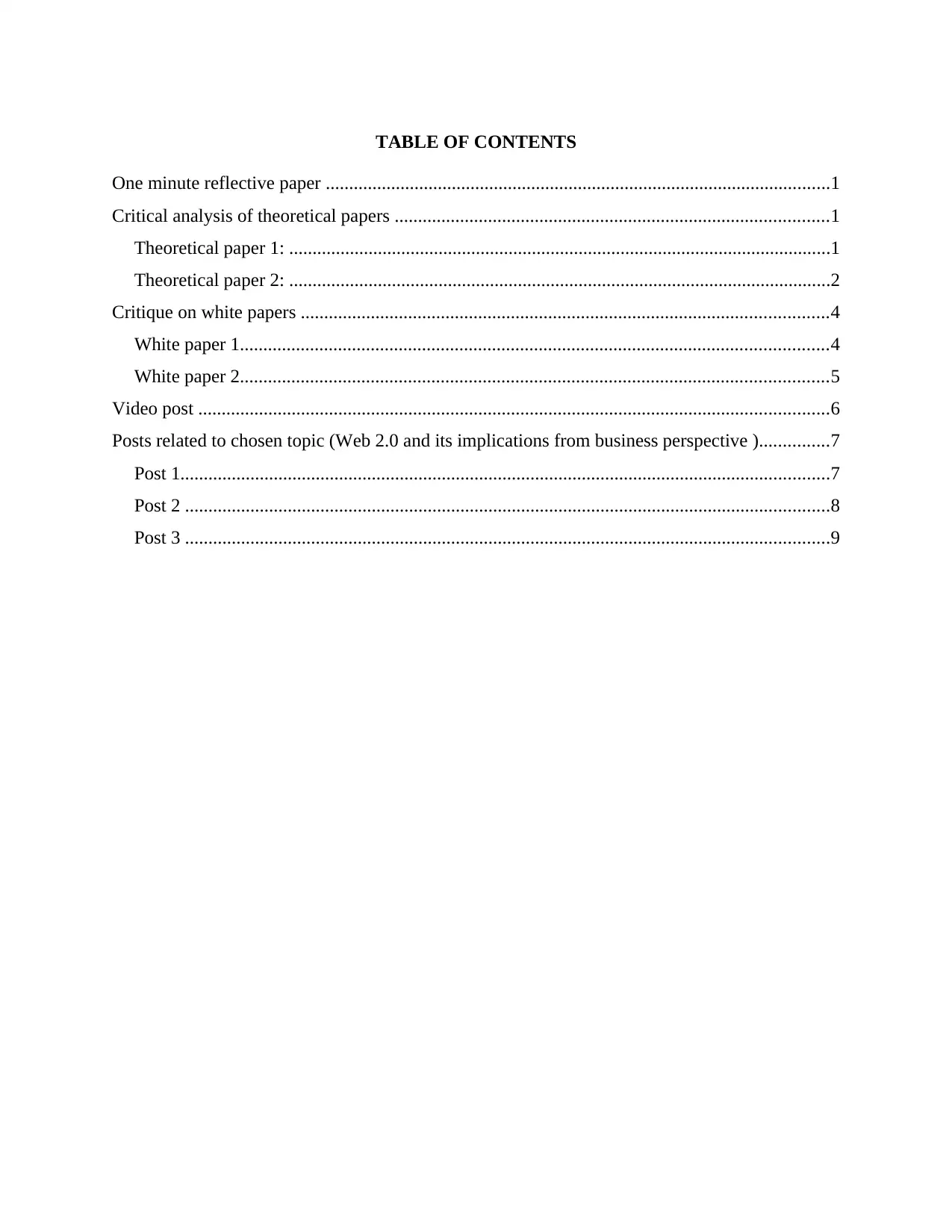
TABLE OF CONTENTS
One minute reflective paper ............................................................................................................1
Critical analysis of theoretical papers .............................................................................................1
Theoretical paper 1: ....................................................................................................................1
Theoretical paper 2: ....................................................................................................................2
Critique on white papers .................................................................................................................4
White paper 1..............................................................................................................................4
White paper 2..............................................................................................................................5
Video post .......................................................................................................................................6
Posts related to chosen topic (Web 2.0 and its implications from business perspective )...............7
Post 1...........................................................................................................................................7
Post 2 ..........................................................................................................................................8
Post 3 ..........................................................................................................................................9
One minute reflective paper ............................................................................................................1
Critical analysis of theoretical papers .............................................................................................1
Theoretical paper 1: ....................................................................................................................1
Theoretical paper 2: ....................................................................................................................2
Critique on white papers .................................................................................................................4
White paper 1..............................................................................................................................4
White paper 2..............................................................................................................................5
Video post .......................................................................................................................................6
Posts related to chosen topic (Web 2.0 and its implications from business perspective )...............7
Post 1...........................................................................................................................................7
Post 2 ..........................................................................................................................................8
Post 3 ..........................................................................................................................................9
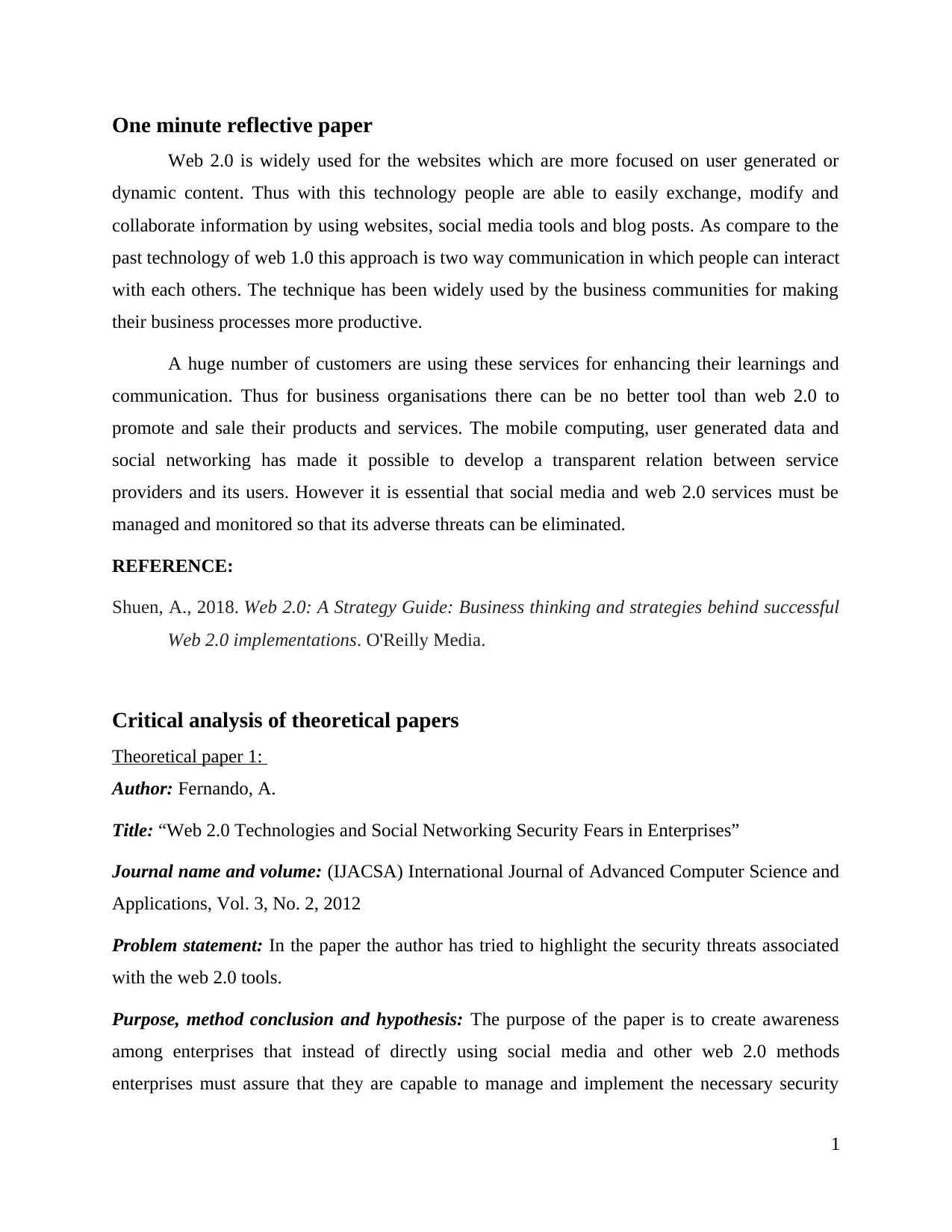
One minute reflective paper
Web 2.0 is widely used for the websites which are more focused on user generated or
dynamic content. Thus with this technology people are able to easily exchange, modify and
collaborate information by using websites, social media tools and blog posts. As compare to the
past technology of web 1.0 this approach is two way communication in which people can interact
with each others. The technique has been widely used by the business communities for making
their business processes more productive.
A huge number of customers are using these services for enhancing their learnings and
communication. Thus for business organisations there can be no better tool than web 2.0 to
promote and sale their products and services. The mobile computing, user generated data and
social networking has made it possible to develop a transparent relation between service
providers and its users. However it is essential that social media and web 2.0 services must be
managed and monitored so that its adverse threats can be eliminated.
REFERENCE:
Shuen, A., 2018. Web 2.0: A Strategy Guide: Business thinking and strategies behind successful
Web 2.0 implementations. O'Reilly Media.
Critical analysis of theoretical papers
Theoretical paper 1:
Author: Fernando, A.
Title: “Web 2.0 Technologies and Social Networking Security Fears in Enterprises”
Journal name and volume: (IJACSA) International Journal of Advanced Computer Science and
Applications, Vol. 3, No. 2, 2012
Problem statement: In the paper the author has tried to highlight the security threats associated
with the web 2.0 tools.
Purpose, method conclusion and hypothesis: The purpose of the paper is to create awareness
among enterprises that instead of directly using social media and other web 2.0 methods
enterprises must assure that they are capable to manage and implement the necessary security
1
Web 2.0 is widely used for the websites which are more focused on user generated or
dynamic content. Thus with this technology people are able to easily exchange, modify and
collaborate information by using websites, social media tools and blog posts. As compare to the
past technology of web 1.0 this approach is two way communication in which people can interact
with each others. The technique has been widely used by the business communities for making
their business processes more productive.
A huge number of customers are using these services for enhancing their learnings and
communication. Thus for business organisations there can be no better tool than web 2.0 to
promote and sale their products and services. The mobile computing, user generated data and
social networking has made it possible to develop a transparent relation between service
providers and its users. However it is essential that social media and web 2.0 services must be
managed and monitored so that its adverse threats can be eliminated.
REFERENCE:
Shuen, A., 2018. Web 2.0: A Strategy Guide: Business thinking and strategies behind successful
Web 2.0 implementations. O'Reilly Media.
Critical analysis of theoretical papers
Theoretical paper 1:
Author: Fernando, A.
Title: “Web 2.0 Technologies and Social Networking Security Fears in Enterprises”
Journal name and volume: (IJACSA) International Journal of Advanced Computer Science and
Applications, Vol. 3, No. 2, 2012
Problem statement: In the paper the author has tried to highlight the security threats associated
with the web 2.0 tools.
Purpose, method conclusion and hypothesis: The purpose of the paper is to create awareness
among enterprises that instead of directly using social media and other web 2.0 methods
enterprises must assure that they are capable to manage and implement the necessary security
1
⊘ This is a preview!⊘
Do you want full access?
Subscribe today to unlock all pages.

Trusted by 1+ million students worldwide
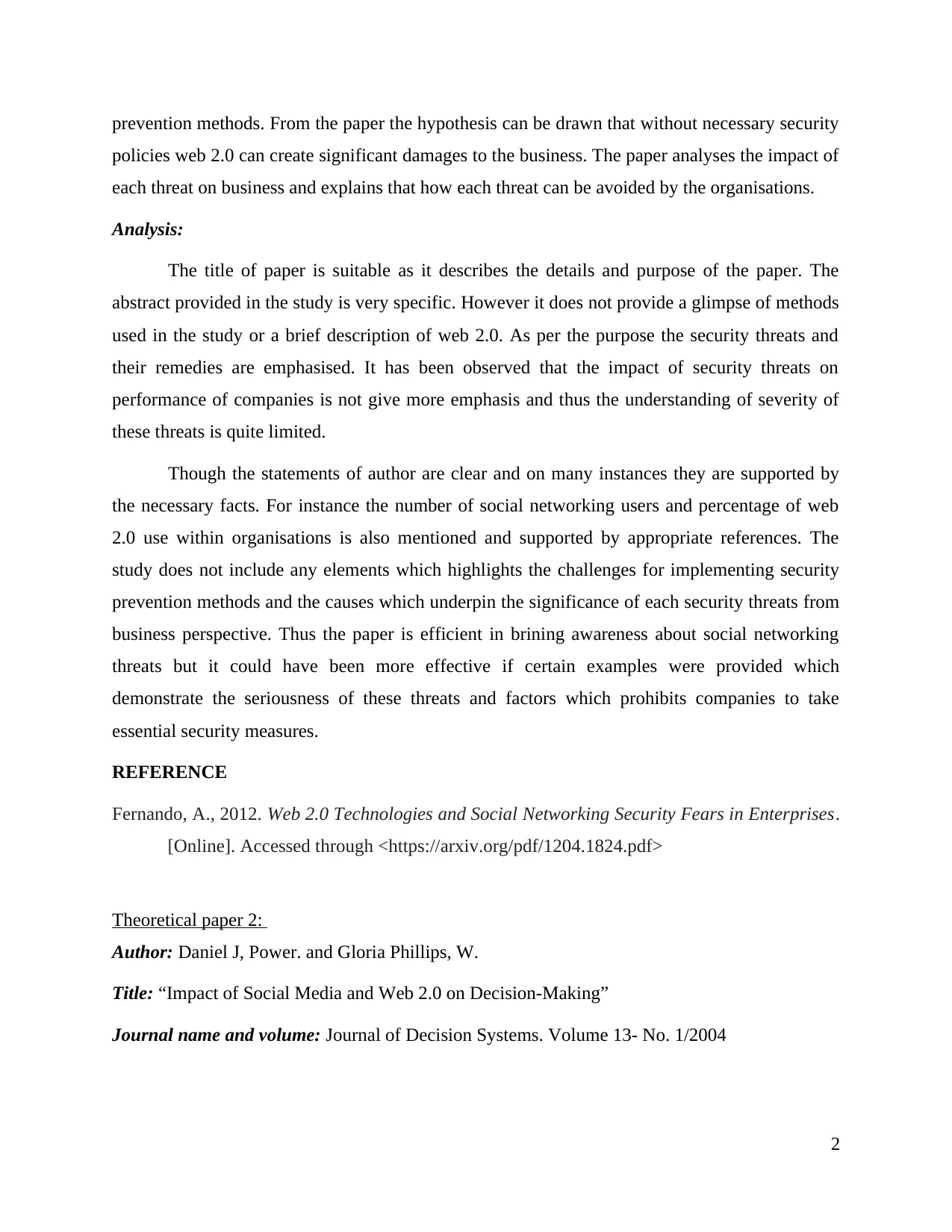
prevention methods. From the paper the hypothesis can be drawn that without necessary security
policies web 2.0 can create significant damages to the business. The paper analyses the impact of
each threat on business and explains that how each threat can be avoided by the organisations.
Analysis:
The title of paper is suitable as it describes the details and purpose of the paper. The
abstract provided in the study is very specific. However it does not provide a glimpse of methods
used in the study or a brief description of web 2.0. As per the purpose the security threats and
their remedies are emphasised. It has been observed that the impact of security threats on
performance of companies is not give more emphasis and thus the understanding of severity of
these threats is quite limited.
Though the statements of author are clear and on many instances they are supported by
the necessary facts. For instance the number of social networking users and percentage of web
2.0 use within organisations is also mentioned and supported by appropriate references. The
study does not include any elements which highlights the challenges for implementing security
prevention methods and the causes which underpin the significance of each security threats from
business perspective. Thus the paper is efficient in brining awareness about social networking
threats but it could have been more effective if certain examples were provided which
demonstrate the seriousness of these threats and factors which prohibits companies to take
essential security measures.
REFERENCE
Fernando, A., 2012. Web 2.0 Technologies and Social Networking Security Fears in Enterprises.
[Online]. Accessed through <https://arxiv.org/pdf/1204.1824.pdf>
Theoretical paper 2:
Author: Daniel J, Power. and Gloria Phillips, W.
Title: “Impact of Social Media and Web 2.0 on Decision-Making”
Journal name and volume: Journal of Decision Systems. Volume 13- No. 1/2004
2
policies web 2.0 can create significant damages to the business. The paper analyses the impact of
each threat on business and explains that how each threat can be avoided by the organisations.
Analysis:
The title of paper is suitable as it describes the details and purpose of the paper. The
abstract provided in the study is very specific. However it does not provide a glimpse of methods
used in the study or a brief description of web 2.0. As per the purpose the security threats and
their remedies are emphasised. It has been observed that the impact of security threats on
performance of companies is not give more emphasis and thus the understanding of severity of
these threats is quite limited.
Though the statements of author are clear and on many instances they are supported by
the necessary facts. For instance the number of social networking users and percentage of web
2.0 use within organisations is also mentioned and supported by appropriate references. The
study does not include any elements which highlights the challenges for implementing security
prevention methods and the causes which underpin the significance of each security threats from
business perspective. Thus the paper is efficient in brining awareness about social networking
threats but it could have been more effective if certain examples were provided which
demonstrate the seriousness of these threats and factors which prohibits companies to take
essential security measures.
REFERENCE
Fernando, A., 2012. Web 2.0 Technologies and Social Networking Security Fears in Enterprises.
[Online]. Accessed through <https://arxiv.org/pdf/1204.1824.pdf>
Theoretical paper 2:
Author: Daniel J, Power. and Gloria Phillips, W.
Title: “Impact of Social Media and Web 2.0 on Decision-Making”
Journal name and volume: Journal of Decision Systems. Volume 13- No. 1/2004
2
Paraphrase This Document
Need a fresh take? Get an instant paraphrase of this document with our AI Paraphraser
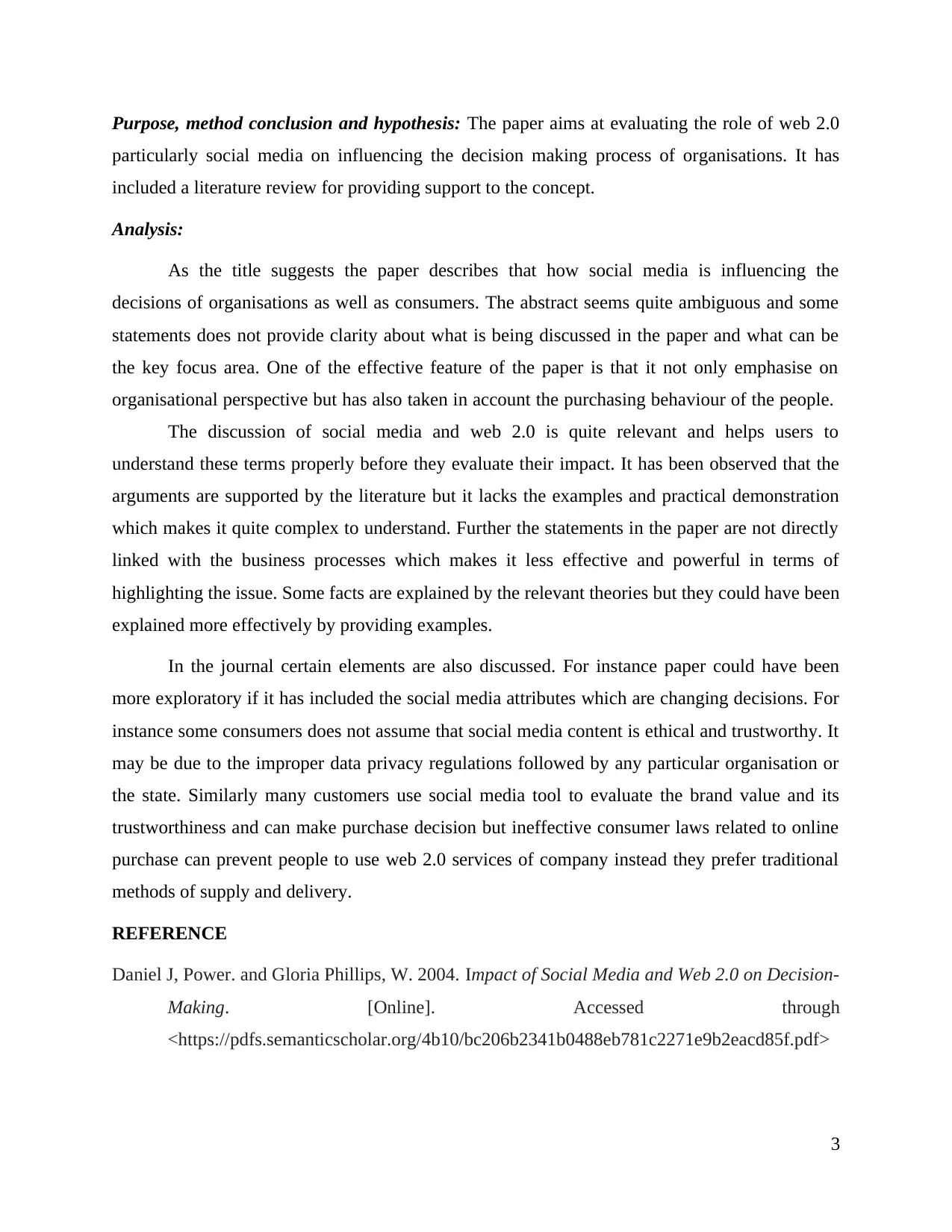
Purpose, method conclusion and hypothesis: The paper aims at evaluating the role of web 2.0
particularly social media on influencing the decision making process of organisations. It has
included a literature review for providing support to the concept.
Analysis:
As the title suggests the paper describes that how social media is influencing the
decisions of organisations as well as consumers. The abstract seems quite ambiguous and some
statements does not provide clarity about what is being discussed in the paper and what can be
the key focus area. One of the effective feature of the paper is that it not only emphasise on
organisational perspective but has also taken in account the purchasing behaviour of the people.
The discussion of social media and web 2.0 is quite relevant and helps users to
understand these terms properly before they evaluate their impact. It has been observed that the
arguments are supported by the literature but it lacks the examples and practical demonstration
which makes it quite complex to understand. Further the statements in the paper are not directly
linked with the business processes which makes it less effective and powerful in terms of
highlighting the issue. Some facts are explained by the relevant theories but they could have been
explained more effectively by providing examples.
In the journal certain elements are also discussed. For instance paper could have been
more exploratory if it has included the social media attributes which are changing decisions. For
instance some consumers does not assume that social media content is ethical and trustworthy. It
may be due to the improper data privacy regulations followed by any particular organisation or
the state. Similarly many customers use social media tool to evaluate the brand value and its
trustworthiness and can make purchase decision but ineffective consumer laws related to online
purchase can prevent people to use web 2.0 services of company instead they prefer traditional
methods of supply and delivery.
REFERENCE
Daniel J, Power. and Gloria Phillips, W. 2004. Impact of Social Media and Web 2.0 on Decision-
Making. [Online]. Accessed through
<https://pdfs.semanticscholar.org/4b10/bc206b2341b0488eb781c2271e9b2eacd85f.pdf>
3
particularly social media on influencing the decision making process of organisations. It has
included a literature review for providing support to the concept.
Analysis:
As the title suggests the paper describes that how social media is influencing the
decisions of organisations as well as consumers. The abstract seems quite ambiguous and some
statements does not provide clarity about what is being discussed in the paper and what can be
the key focus area. One of the effective feature of the paper is that it not only emphasise on
organisational perspective but has also taken in account the purchasing behaviour of the people.
The discussion of social media and web 2.0 is quite relevant and helps users to
understand these terms properly before they evaluate their impact. It has been observed that the
arguments are supported by the literature but it lacks the examples and practical demonstration
which makes it quite complex to understand. Further the statements in the paper are not directly
linked with the business processes which makes it less effective and powerful in terms of
highlighting the issue. Some facts are explained by the relevant theories but they could have been
explained more effectively by providing examples.
In the journal certain elements are also discussed. For instance paper could have been
more exploratory if it has included the social media attributes which are changing decisions. For
instance some consumers does not assume that social media content is ethical and trustworthy. It
may be due to the improper data privacy regulations followed by any particular organisation or
the state. Similarly many customers use social media tool to evaluate the brand value and its
trustworthiness and can make purchase decision but ineffective consumer laws related to online
purchase can prevent people to use web 2.0 services of company instead they prefer traditional
methods of supply and delivery.
REFERENCE
Daniel J, Power. and Gloria Phillips, W. 2004. Impact of Social Media and Web 2.0 on Decision-
Making. [Online]. Accessed through
<https://pdfs.semanticscholar.org/4b10/bc206b2341b0488eb781c2271e9b2eacd85f.pdf>
3
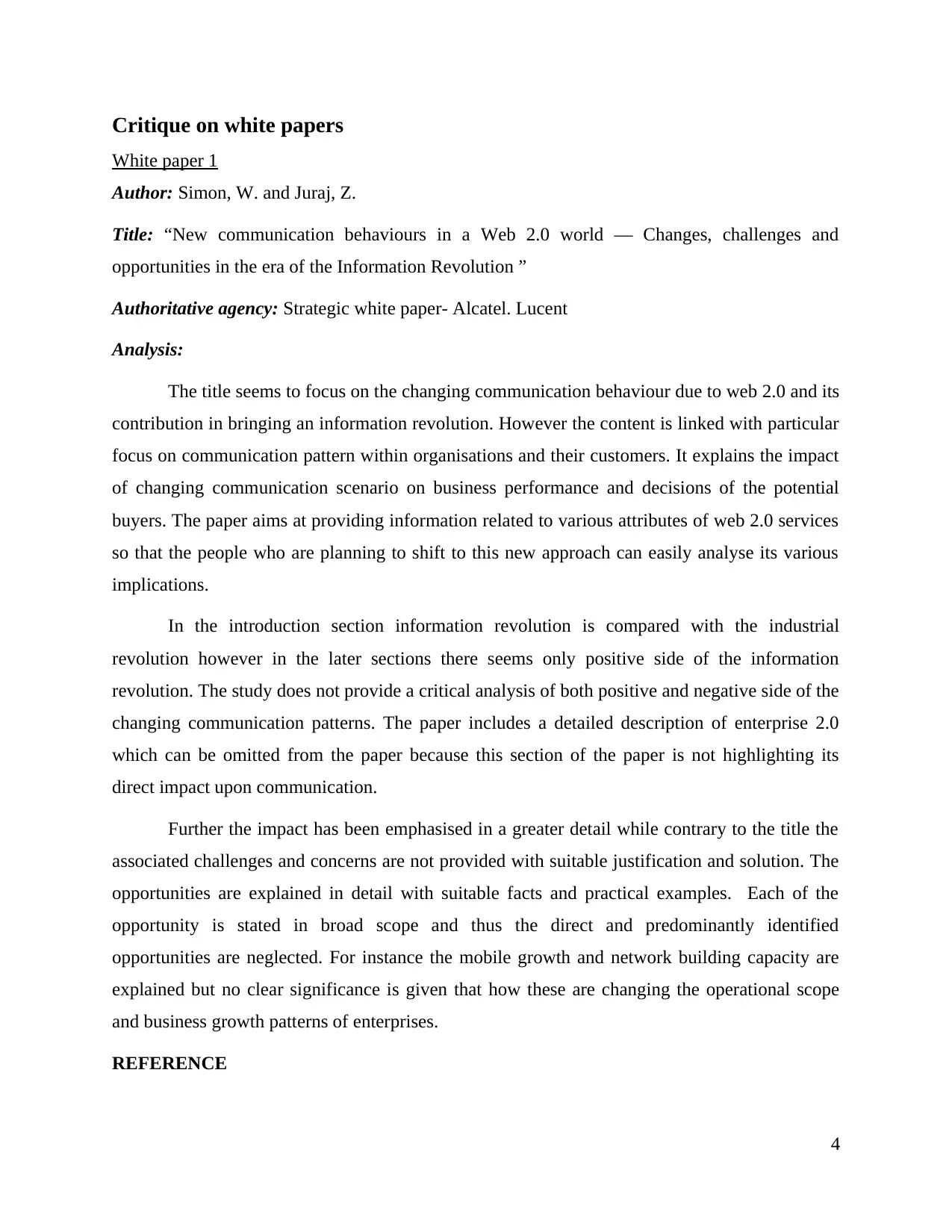
Critique on white papers
White paper 1
Author: Simon, W. and Juraj, Z.
Title: “New communication behaviours in a Web 2.0 world — Changes, challenges and
opportunities in the era of the Information Revolution ”
Authoritative agency: Strategic white paper- Alcatel. Lucent
Analysis:
The title seems to focus on the changing communication behaviour due to web 2.0 and its
contribution in bringing an information revolution. However the content is linked with particular
focus on communication pattern within organisations and their customers. It explains the impact
of changing communication scenario on business performance and decisions of the potential
buyers. The paper aims at providing information related to various attributes of web 2.0 services
so that the people who are planning to shift to this new approach can easily analyse its various
implications.
In the introduction section information revolution is compared with the industrial
revolution however in the later sections there seems only positive side of the information
revolution. The study does not provide a critical analysis of both positive and negative side of the
changing communication patterns. The paper includes a detailed description of enterprise 2.0
which can be omitted from the paper because this section of the paper is not highlighting its
direct impact upon communication.
Further the impact has been emphasised in a greater detail while contrary to the title the
associated challenges and concerns are not provided with suitable justification and solution. The
opportunities are explained in detail with suitable facts and practical examples. Each of the
opportunity is stated in broad scope and thus the direct and predominantly identified
opportunities are neglected. For instance the mobile growth and network building capacity are
explained but no clear significance is given that how these are changing the operational scope
and business growth patterns of enterprises.
REFERENCE
4
White paper 1
Author: Simon, W. and Juraj, Z.
Title: “New communication behaviours in a Web 2.0 world — Changes, challenges and
opportunities in the era of the Information Revolution ”
Authoritative agency: Strategic white paper- Alcatel. Lucent
Analysis:
The title seems to focus on the changing communication behaviour due to web 2.0 and its
contribution in bringing an information revolution. However the content is linked with particular
focus on communication pattern within organisations and their customers. It explains the impact
of changing communication scenario on business performance and decisions of the potential
buyers. The paper aims at providing information related to various attributes of web 2.0 services
so that the people who are planning to shift to this new approach can easily analyse its various
implications.
In the introduction section information revolution is compared with the industrial
revolution however in the later sections there seems only positive side of the information
revolution. The study does not provide a critical analysis of both positive and negative side of the
changing communication patterns. The paper includes a detailed description of enterprise 2.0
which can be omitted from the paper because this section of the paper is not highlighting its
direct impact upon communication.
Further the impact has been emphasised in a greater detail while contrary to the title the
associated challenges and concerns are not provided with suitable justification and solution. The
opportunities are explained in detail with suitable facts and practical examples. Each of the
opportunity is stated in broad scope and thus the direct and predominantly identified
opportunities are neglected. For instance the mobile growth and network building capacity are
explained but no clear significance is given that how these are changing the operational scope
and business growth patterns of enterprises.
REFERENCE
4
⊘ This is a preview!⊘
Do you want full access?
Subscribe today to unlock all pages.

Trusted by 1+ million students worldwide
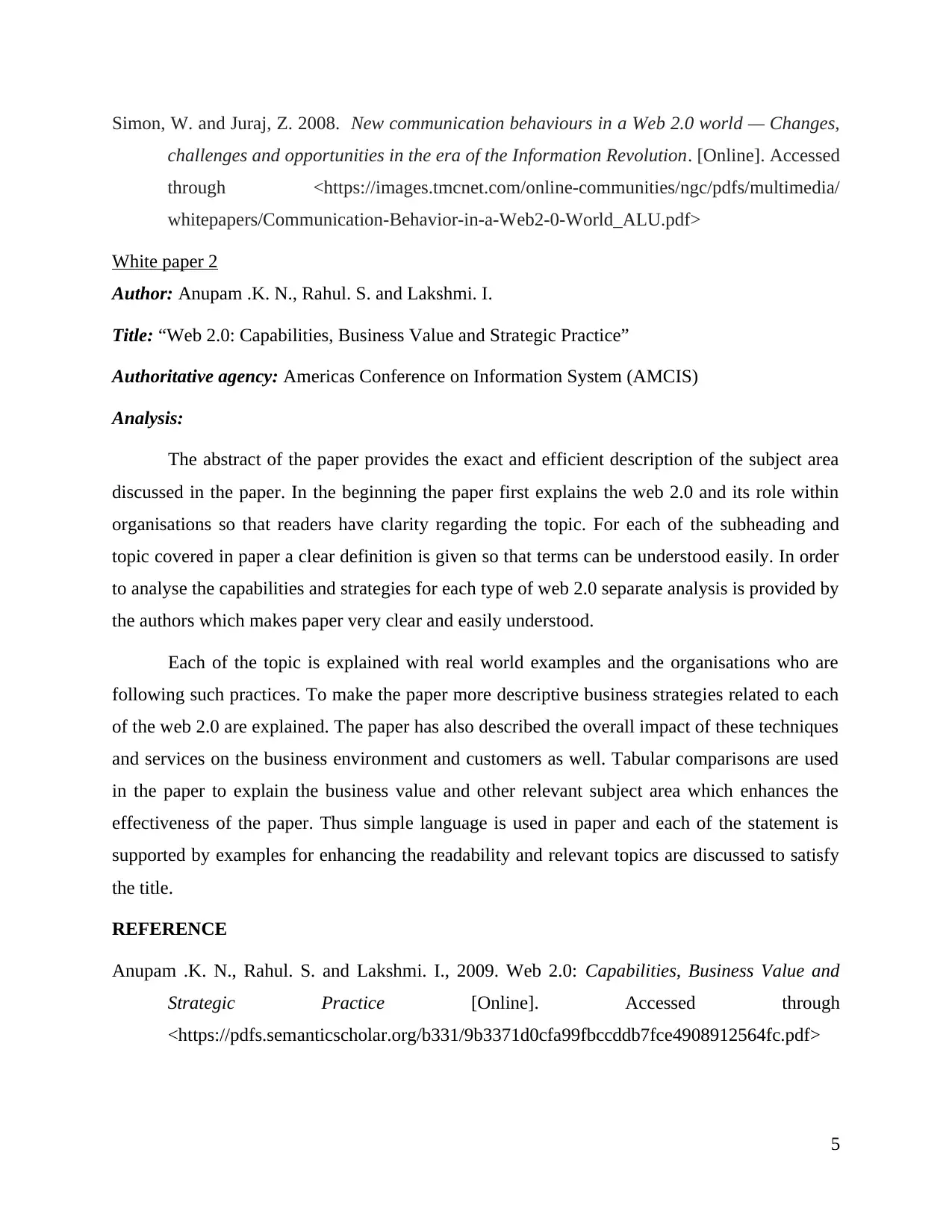
Simon, W. and Juraj, Z. 2008. New communication behaviours in a Web 2.0 world — Changes,
challenges and opportunities in the era of the Information Revolution. [Online]. Accessed
through <https://images.tmcnet.com/online-communities/ngc/pdfs/multimedia/
whitepapers/Communication-Behavior-in-a-Web2-0-World_ALU.pdf>
White paper 2
Author: Anupam .K. N., Rahul. S. and Lakshmi. I.
Title: “Web 2.0: Capabilities, Business Value and Strategic Practice”
Authoritative agency: Americas Conference on Information System (AMCIS)
Analysis:
The abstract of the paper provides the exact and efficient description of the subject area
discussed in the paper. In the beginning the paper first explains the web 2.0 and its role within
organisations so that readers have clarity regarding the topic. For each of the subheading and
topic covered in paper a clear definition is given so that terms can be understood easily. In order
to analyse the capabilities and strategies for each type of web 2.0 separate analysis is provided by
the authors which makes paper very clear and easily understood.
Each of the topic is explained with real world examples and the organisations who are
following such practices. To make the paper more descriptive business strategies related to each
of the web 2.0 are explained. The paper has also described the overall impact of these techniques
and services on the business environment and customers as well. Tabular comparisons are used
in the paper to explain the business value and other relevant subject area which enhances the
effectiveness of the paper. Thus simple language is used in paper and each of the statement is
supported by examples for enhancing the readability and relevant topics are discussed to satisfy
the title.
REFERENCE
Anupam .K. N., Rahul. S. and Lakshmi. I., 2009. Web 2.0: Capabilities, Business Value and
Strategic Practice [Online]. Accessed through
<https://pdfs.semanticscholar.org/b331/9b3371d0cfa99fbccddb7fce4908912564fc.pdf>
5
challenges and opportunities in the era of the Information Revolution. [Online]. Accessed
through <https://images.tmcnet.com/online-communities/ngc/pdfs/multimedia/
whitepapers/Communication-Behavior-in-a-Web2-0-World_ALU.pdf>
White paper 2
Author: Anupam .K. N., Rahul. S. and Lakshmi. I.
Title: “Web 2.0: Capabilities, Business Value and Strategic Practice”
Authoritative agency: Americas Conference on Information System (AMCIS)
Analysis:
The abstract of the paper provides the exact and efficient description of the subject area
discussed in the paper. In the beginning the paper first explains the web 2.0 and its role within
organisations so that readers have clarity regarding the topic. For each of the subheading and
topic covered in paper a clear definition is given so that terms can be understood easily. In order
to analyse the capabilities and strategies for each type of web 2.0 separate analysis is provided by
the authors which makes paper very clear and easily understood.
Each of the topic is explained with real world examples and the organisations who are
following such practices. To make the paper more descriptive business strategies related to each
of the web 2.0 are explained. The paper has also described the overall impact of these techniques
and services on the business environment and customers as well. Tabular comparisons are used
in the paper to explain the business value and other relevant subject area which enhances the
effectiveness of the paper. Thus simple language is used in paper and each of the statement is
supported by examples for enhancing the readability and relevant topics are discussed to satisfy
the title.
REFERENCE
Anupam .K. N., Rahul. S. and Lakshmi. I., 2009. Web 2.0: Capabilities, Business Value and
Strategic Practice [Online]. Accessed through
<https://pdfs.semanticscholar.org/b331/9b3371d0cfa99fbccddb7fce4908912564fc.pdf>
5
Paraphrase This Document
Need a fresh take? Get an instant paraphrase of this document with our AI Paraphraser
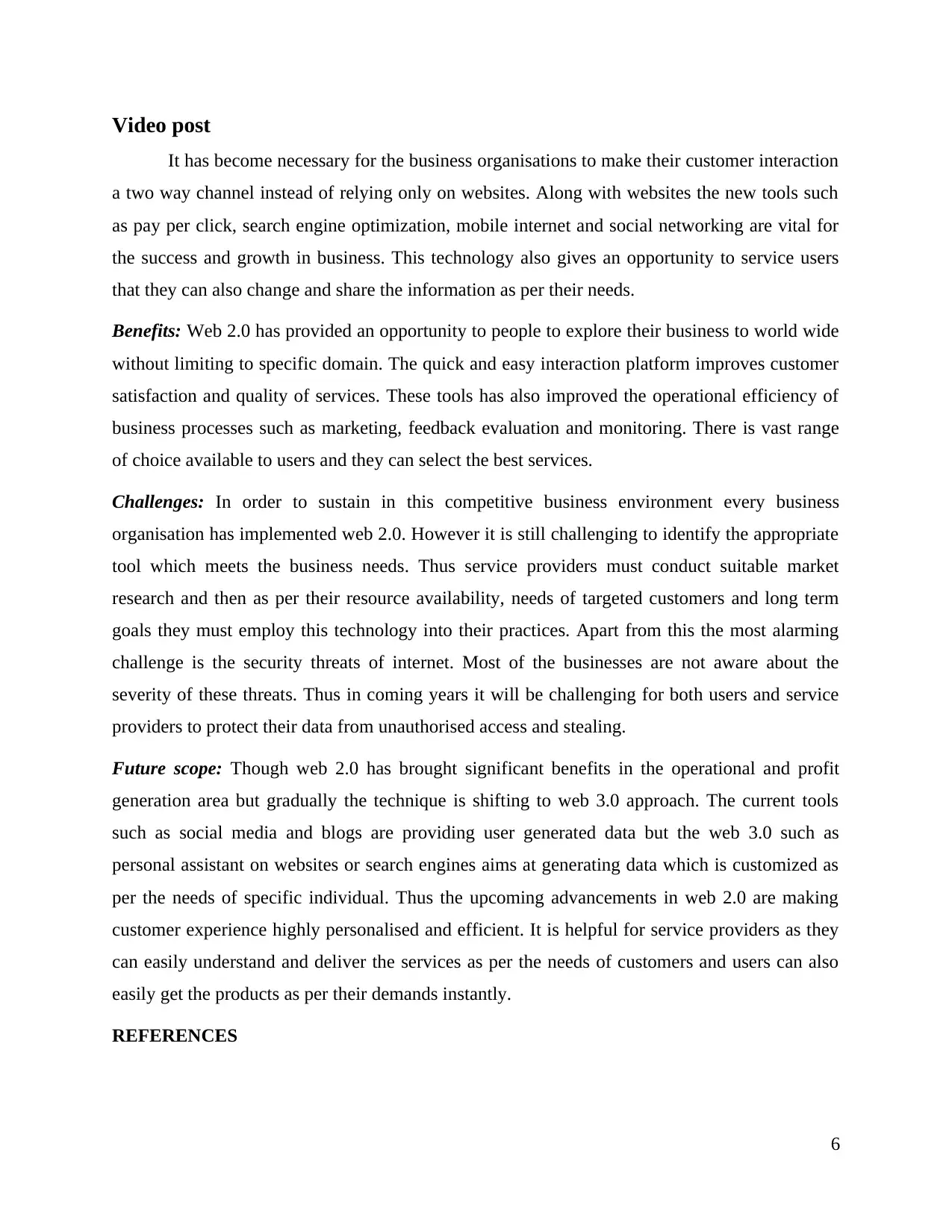
Video post
It has become necessary for the business organisations to make their customer interaction
a two way channel instead of relying only on websites. Along with websites the new tools such
as pay per click, search engine optimization, mobile internet and social networking are vital for
the success and growth in business. This technology also gives an opportunity to service users
that they can also change and share the information as per their needs.
Benefits: Web 2.0 has provided an opportunity to people to explore their business to world wide
without limiting to specific domain. The quick and easy interaction platform improves customer
satisfaction and quality of services. These tools has also improved the operational efficiency of
business processes such as marketing, feedback evaluation and monitoring. There is vast range
of choice available to users and they can select the best services.
Challenges: In order to sustain in this competitive business environment every business
organisation has implemented web 2.0. However it is still challenging to identify the appropriate
tool which meets the business needs. Thus service providers must conduct suitable market
research and then as per their resource availability, needs of targeted customers and long term
goals they must employ this technology into their practices. Apart from this the most alarming
challenge is the security threats of internet. Most of the businesses are not aware about the
severity of these threats. Thus in coming years it will be challenging for both users and service
providers to protect their data from unauthorised access and stealing.
Future scope: Though web 2.0 has brought significant benefits in the operational and profit
generation area but gradually the technique is shifting to web 3.0 approach. The current tools
such as social media and blogs are providing user generated data but the web 3.0 such as
personal assistant on websites or search engines aims at generating data which is customized as
per the needs of specific individual. Thus the upcoming advancements in web 2.0 are making
customer experience highly personalised and efficient. It is helpful for service providers as they
can easily understand and deliver the services as per the needs of customers and users can also
easily get the products as per their demands instantly.
REFERENCES
6
It has become necessary for the business organisations to make their customer interaction
a two way channel instead of relying only on websites. Along with websites the new tools such
as pay per click, search engine optimization, mobile internet and social networking are vital for
the success and growth in business. This technology also gives an opportunity to service users
that they can also change and share the information as per their needs.
Benefits: Web 2.0 has provided an opportunity to people to explore their business to world wide
without limiting to specific domain. The quick and easy interaction platform improves customer
satisfaction and quality of services. These tools has also improved the operational efficiency of
business processes such as marketing, feedback evaluation and monitoring. There is vast range
of choice available to users and they can select the best services.
Challenges: In order to sustain in this competitive business environment every business
organisation has implemented web 2.0. However it is still challenging to identify the appropriate
tool which meets the business needs. Thus service providers must conduct suitable market
research and then as per their resource availability, needs of targeted customers and long term
goals they must employ this technology into their practices. Apart from this the most alarming
challenge is the security threats of internet. Most of the businesses are not aware about the
severity of these threats. Thus in coming years it will be challenging for both users and service
providers to protect their data from unauthorised access and stealing.
Future scope: Though web 2.0 has brought significant benefits in the operational and profit
generation area but gradually the technique is shifting to web 3.0 approach. The current tools
such as social media and blogs are providing user generated data but the web 3.0 such as
personal assistant on websites or search engines aims at generating data which is customized as
per the needs of specific individual. Thus the upcoming advancements in web 2.0 are making
customer experience highly personalised and efficient. It is helpful for service providers as they
can easily understand and deliver the services as per the needs of customers and users can also
easily get the products as per their demands instantly.
REFERENCES
6
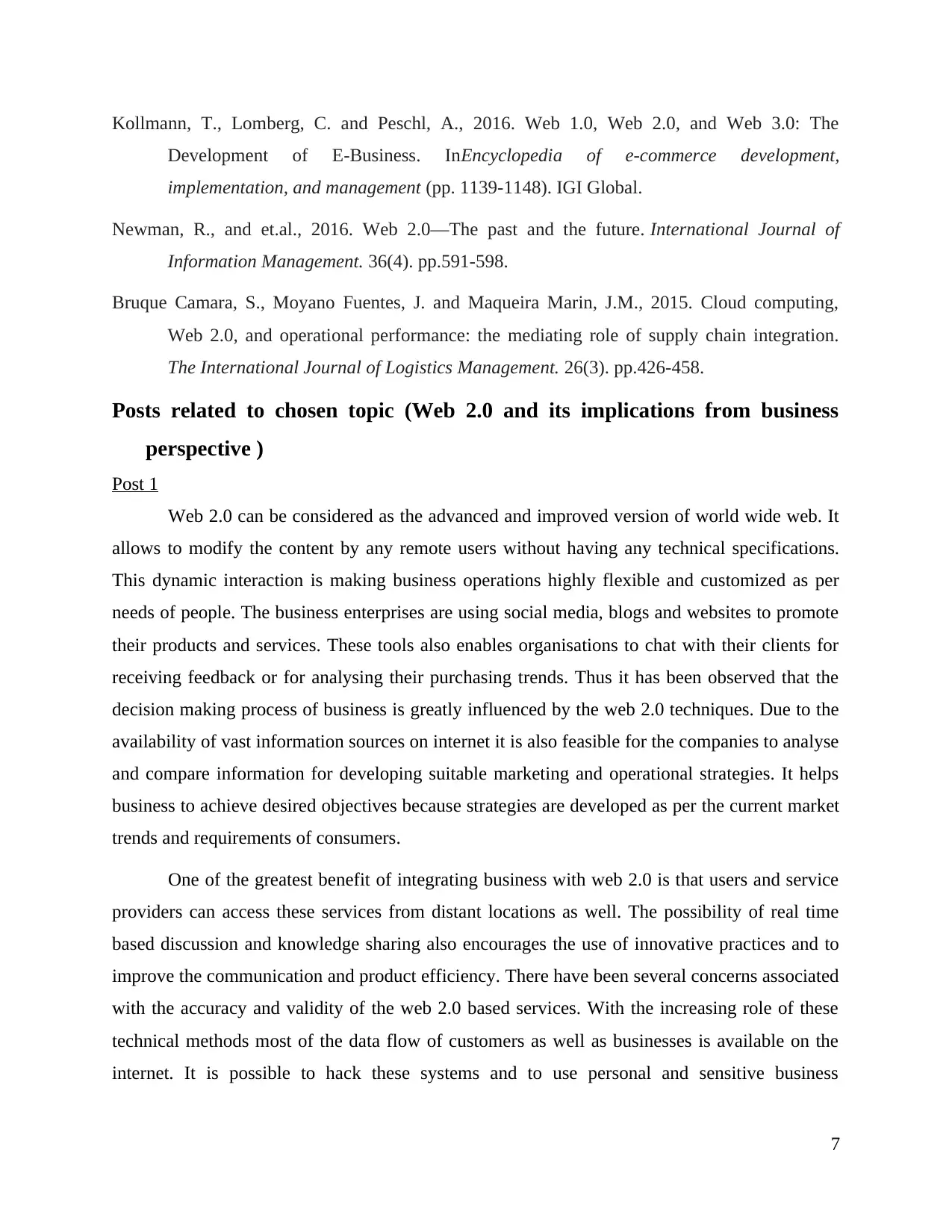
Kollmann, T., Lomberg, C. and Peschl, A., 2016. Web 1.0, Web 2.0, and Web 3.0: The
Development of E-Business. InEncyclopedia of e-commerce development,
implementation, and management (pp. 1139-1148). IGI Global.
Newman, R., and et.al., 2016. Web 2.0—The past and the future. International Journal of
Information Management. 36(4). pp.591-598.
Bruque Camara, S., Moyano Fuentes, J. and Maqueira Marin, J.M., 2015. Cloud computing,
Web 2.0, and operational performance: the mediating role of supply chain integration.
The International Journal of Logistics Management. 26(3). pp.426-458.
Posts related to chosen topic (Web 2.0 and its implications from business
perspective )
Post 1
Web 2.0 can be considered as the advanced and improved version of world wide web. It
allows to modify the content by any remote users without having any technical specifications.
This dynamic interaction is making business operations highly flexible and customized as per
needs of people. The business enterprises are using social media, blogs and websites to promote
their products and services. These tools also enables organisations to chat with their clients for
receiving feedback or for analysing their purchasing trends. Thus it has been observed that the
decision making process of business is greatly influenced by the web 2.0 techniques. Due to the
availability of vast information sources on internet it is also feasible for the companies to analyse
and compare information for developing suitable marketing and operational strategies. It helps
business to achieve desired objectives because strategies are developed as per the current market
trends and requirements of consumers.
One of the greatest benefit of integrating business with web 2.0 is that users and service
providers can access these services from distant locations as well. The possibility of real time
based discussion and knowledge sharing also encourages the use of innovative practices and to
improve the communication and product efficiency. There have been several concerns associated
with the accuracy and validity of the web 2.0 based services. With the increasing role of these
technical methods most of the data flow of customers as well as businesses is available on the
internet. It is possible to hack these systems and to use personal and sensitive business
7
Development of E-Business. InEncyclopedia of e-commerce development,
implementation, and management (pp. 1139-1148). IGI Global.
Newman, R., and et.al., 2016. Web 2.0—The past and the future. International Journal of
Information Management. 36(4). pp.591-598.
Bruque Camara, S., Moyano Fuentes, J. and Maqueira Marin, J.M., 2015. Cloud computing,
Web 2.0, and operational performance: the mediating role of supply chain integration.
The International Journal of Logistics Management. 26(3). pp.426-458.
Posts related to chosen topic (Web 2.0 and its implications from business
perspective )
Post 1
Web 2.0 can be considered as the advanced and improved version of world wide web. It
allows to modify the content by any remote users without having any technical specifications.
This dynamic interaction is making business operations highly flexible and customized as per
needs of people. The business enterprises are using social media, blogs and websites to promote
their products and services. These tools also enables organisations to chat with their clients for
receiving feedback or for analysing their purchasing trends. Thus it has been observed that the
decision making process of business is greatly influenced by the web 2.0 techniques. Due to the
availability of vast information sources on internet it is also feasible for the companies to analyse
and compare information for developing suitable marketing and operational strategies. It helps
business to achieve desired objectives because strategies are developed as per the current market
trends and requirements of consumers.
One of the greatest benefit of integrating business with web 2.0 is that users and service
providers can access these services from distant locations as well. The possibility of real time
based discussion and knowledge sharing also encourages the use of innovative practices and to
improve the communication and product efficiency. There have been several concerns associated
with the accuracy and validity of the web 2.0 based services. With the increasing role of these
technical methods most of the data flow of customers as well as businesses is available on the
internet. It is possible to hack these systems and to use personal and sensitive business
7
⊘ This is a preview!⊘
Do you want full access?
Subscribe today to unlock all pages.

Trusted by 1+ million students worldwide

information. Thus it is required that business groups must consider the security challenges and
their solutions before they directly implement or use social media or internet.
Most of the enterprises are simply influenced by the benefits of internet and thus they
implement these tools without analysing the possible threats or options for them. For instance
there are small enterprises who manages social media account by following the foot steps of
successful organisations but these small organisations do not have proper monitoring strategies
to monitor the business activities on internet. On social media the information generated cannot
be considered as credible or ethical. Thus it is also possible that negative rumours related to
organisations are easily believed by service users which can influence its performance. Hence it
is essential for the companies to be careful while using web based and networking services for
enhancing their business quality.
REFERENCE
Brengarth, L.B. and Mujkic, E., 2016. WEB 2.0: How social media applications leverage
nonprofit responses during a wildfire crisis. Computers in Human Behavior. 54. pp.589-
596.
Post 2
There has been a constant debate that if enterprises should pause for a while before
exploring further transformation of web 2.0 or should continue to rapid advancements in
technology. The key reason for this debate is the security concerns which are gaining attention of
every service user and provider as well. There is no doubt that web 2.0 are highly efficient in
terms of time and speed. The information can be easily shared and stored so that content can be
prioritize and customized as per the specific needs of individuals. However the increased
dependency of the people on internet based tools has also encouraged several challenges.
The easy access to the online content puts a question mark on the credibility and legacy
of the information. For instance it is very easy to just post a few negative comments on the
services of an organisation and then within few days its performance will get affected. Thus there
is need for organisations to ensure that such negative publicity does not affect their brand value
and trustworthy image. It is possible for the users to share data without any restrictions which
can violate the legal aspects related to privacy and copyrights. The user of internet has definitely
simplified the operational processes but if these security concerns are not addressed properly
8
their solutions before they directly implement or use social media or internet.
Most of the enterprises are simply influenced by the benefits of internet and thus they
implement these tools without analysing the possible threats or options for them. For instance
there are small enterprises who manages social media account by following the foot steps of
successful organisations but these small organisations do not have proper monitoring strategies
to monitor the business activities on internet. On social media the information generated cannot
be considered as credible or ethical. Thus it is also possible that negative rumours related to
organisations are easily believed by service users which can influence its performance. Hence it
is essential for the companies to be careful while using web based and networking services for
enhancing their business quality.
REFERENCE
Brengarth, L.B. and Mujkic, E., 2016. WEB 2.0: How social media applications leverage
nonprofit responses during a wildfire crisis. Computers in Human Behavior. 54. pp.589-
596.
Post 2
There has been a constant debate that if enterprises should pause for a while before
exploring further transformation of web 2.0 or should continue to rapid advancements in
technology. The key reason for this debate is the security concerns which are gaining attention of
every service user and provider as well. There is no doubt that web 2.0 are highly efficient in
terms of time and speed. The information can be easily shared and stored so that content can be
prioritize and customized as per the specific needs of individuals. However the increased
dependency of the people on internet based tools has also encouraged several challenges.
The easy access to the online content puts a question mark on the credibility and legacy
of the information. For instance it is very easy to just post a few negative comments on the
services of an organisation and then within few days its performance will get affected. Thus there
is need for organisations to ensure that such negative publicity does not affect their brand value
and trustworthy image. It is possible for the users to share data without any restrictions which
can violate the legal aspects related to privacy and copyrights. The user of internet has definitely
simplified the operational processes but if these security concerns are not addressed properly
8
Paraphrase This Document
Need a fresh take? Get an instant paraphrase of this document with our AI Paraphraser
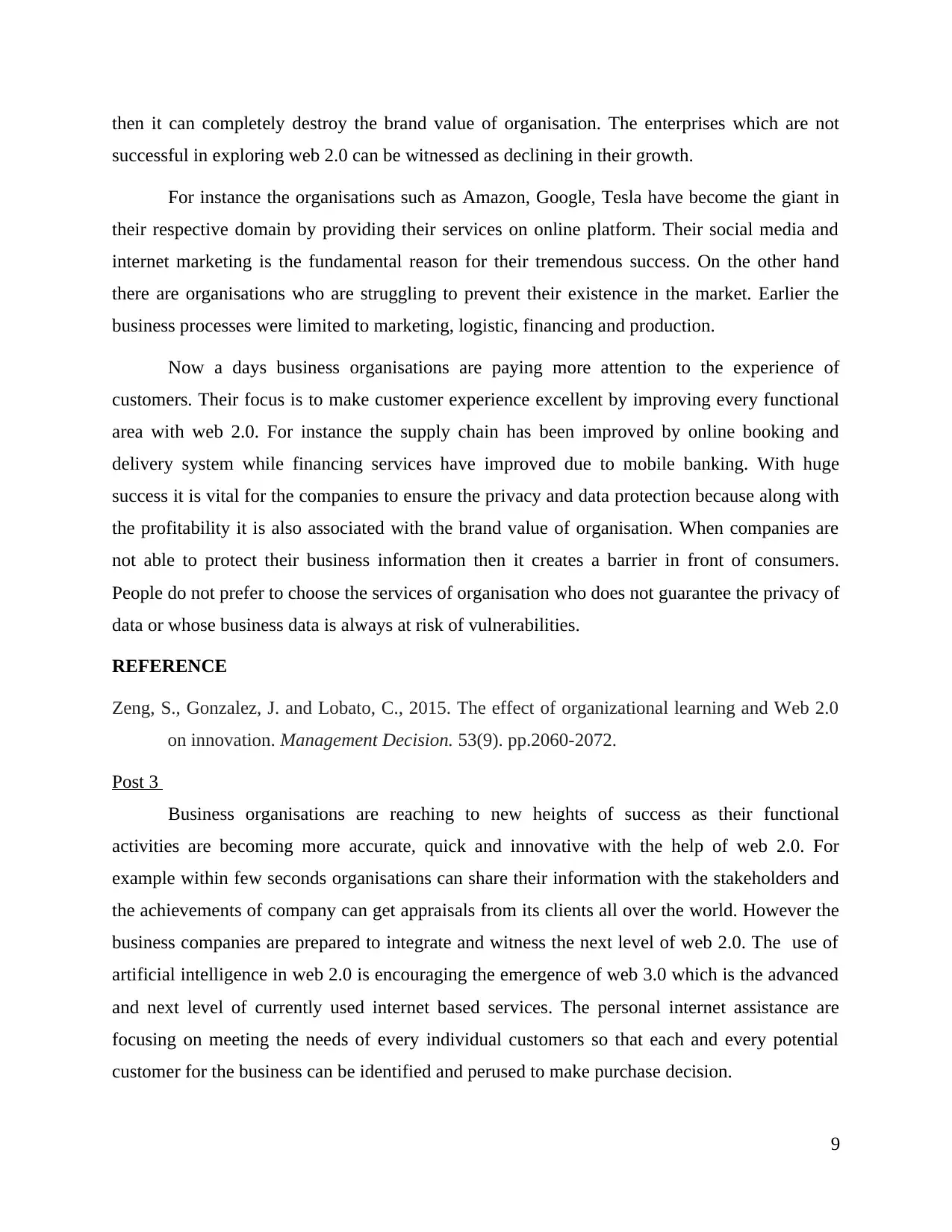
then it can completely destroy the brand value of organisation. The enterprises which are not
successful in exploring web 2.0 can be witnessed as declining in their growth.
For instance the organisations such as Amazon, Google, Tesla have become the giant in
their respective domain by providing their services on online platform. Their social media and
internet marketing is the fundamental reason for their tremendous success. On the other hand
there are organisations who are struggling to prevent their existence in the market. Earlier the
business processes were limited to marketing, logistic, financing and production.
Now a days business organisations are paying more attention to the experience of
customers. Their focus is to make customer experience excellent by improving every functional
area with web 2.0. For instance the supply chain has been improved by online booking and
delivery system while financing services have improved due to mobile banking. With huge
success it is vital for the companies to ensure the privacy and data protection because along with
the profitability it is also associated with the brand value of organisation. When companies are
not able to protect their business information then it creates a barrier in front of consumers.
People do not prefer to choose the services of organisation who does not guarantee the privacy of
data or whose business data is always at risk of vulnerabilities.
REFERENCE
Zeng, S., Gonzalez, J. and Lobato, C., 2015. The effect of organizational learning and Web 2.0
on innovation. Management Decision. 53(9). pp.2060-2072.
Post 3
Business organisations are reaching to new heights of success as their functional
activities are becoming more accurate, quick and innovative with the help of web 2.0. For
example within few seconds organisations can share their information with the stakeholders and
the achievements of company can get appraisals from its clients all over the world. However the
business companies are prepared to integrate and witness the next level of web 2.0. The use of
artificial intelligence in web 2.0 is encouraging the emergence of web 3.0 which is the advanced
and next level of currently used internet based services. The personal internet assistance are
focusing on meeting the needs of every individual customers so that each and every potential
customer for the business can be identified and perused to make purchase decision.
9
successful in exploring web 2.0 can be witnessed as declining in their growth.
For instance the organisations such as Amazon, Google, Tesla have become the giant in
their respective domain by providing their services on online platform. Their social media and
internet marketing is the fundamental reason for their tremendous success. On the other hand
there are organisations who are struggling to prevent their existence in the market. Earlier the
business processes were limited to marketing, logistic, financing and production.
Now a days business organisations are paying more attention to the experience of
customers. Their focus is to make customer experience excellent by improving every functional
area with web 2.0. For instance the supply chain has been improved by online booking and
delivery system while financing services have improved due to mobile banking. With huge
success it is vital for the companies to ensure the privacy and data protection because along with
the profitability it is also associated with the brand value of organisation. When companies are
not able to protect their business information then it creates a barrier in front of consumers.
People do not prefer to choose the services of organisation who does not guarantee the privacy of
data or whose business data is always at risk of vulnerabilities.
REFERENCE
Zeng, S., Gonzalez, J. and Lobato, C., 2015. The effect of organizational learning and Web 2.0
on innovation. Management Decision. 53(9). pp.2060-2072.
Post 3
Business organisations are reaching to new heights of success as their functional
activities are becoming more accurate, quick and innovative with the help of web 2.0. For
example within few seconds organisations can share their information with the stakeholders and
the achievements of company can get appraisals from its clients all over the world. However the
business companies are prepared to integrate and witness the next level of web 2.0. The use of
artificial intelligence in web 2.0 is encouraging the emergence of web 3.0 which is the advanced
and next level of currently used internet based services. The personal internet assistance are
focusing on meeting the needs of every individual customers so that each and every potential
customer for the business can be identified and perused to make purchase decision.
9
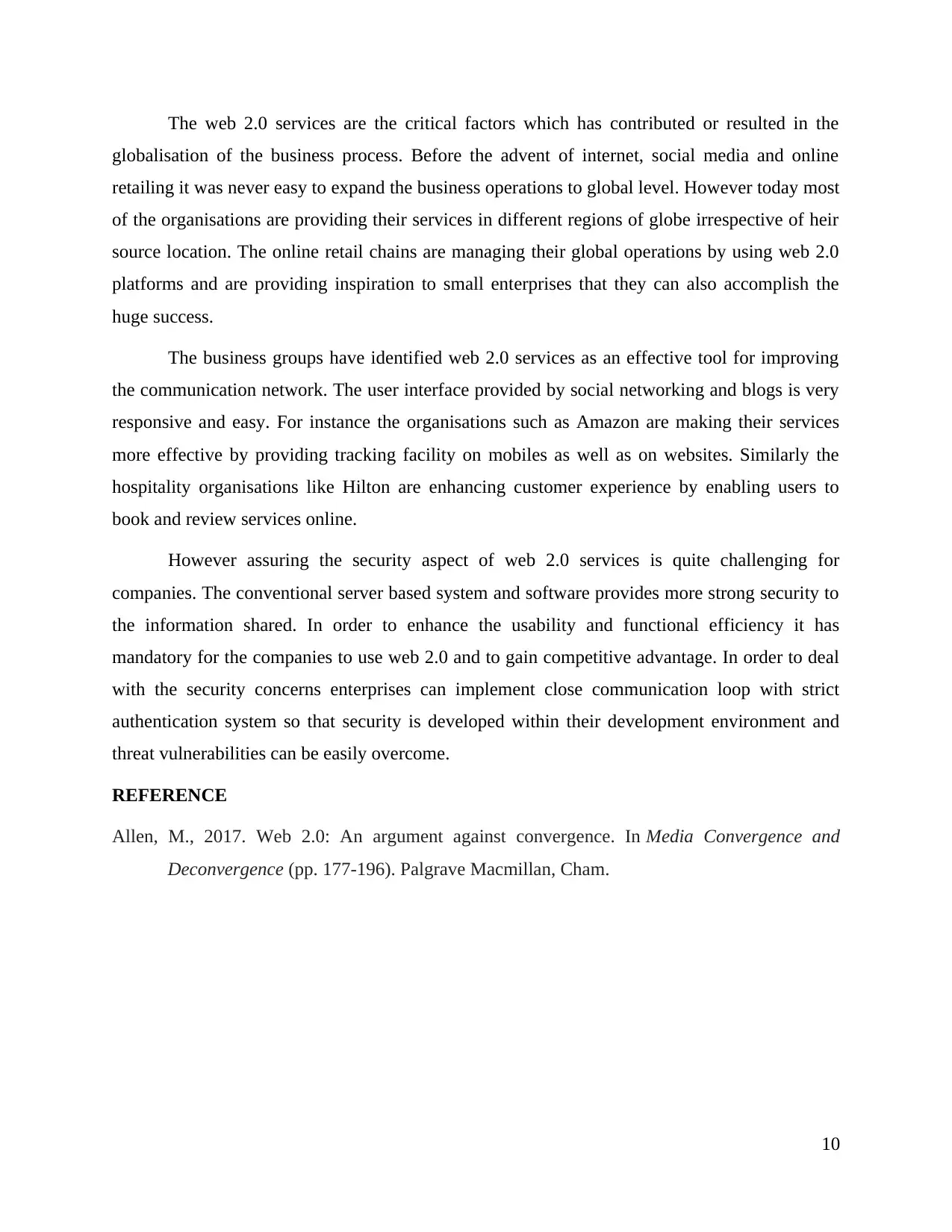
The web 2.0 services are the critical factors which has contributed or resulted in the
globalisation of the business process. Before the advent of internet, social media and online
retailing it was never easy to expand the business operations to global level. However today most
of the organisations are providing their services in different regions of globe irrespective of heir
source location. The online retail chains are managing their global operations by using web 2.0
platforms and are providing inspiration to small enterprises that they can also accomplish the
huge success.
The business groups have identified web 2.0 services as an effective tool for improving
the communication network. The user interface provided by social networking and blogs is very
responsive and easy. For instance the organisations such as Amazon are making their services
more effective by providing tracking facility on mobiles as well as on websites. Similarly the
hospitality organisations like Hilton are enhancing customer experience by enabling users to
book and review services online.
However assuring the security aspect of web 2.0 services is quite challenging for
companies. The conventional server based system and software provides more strong security to
the information shared. In order to enhance the usability and functional efficiency it has
mandatory for the companies to use web 2.0 and to gain competitive advantage. In order to deal
with the security concerns enterprises can implement close communication loop with strict
authentication system so that security is developed within their development environment and
threat vulnerabilities can be easily overcome.
REFERENCE
Allen, M., 2017. Web 2.0: An argument against convergence. In Media Convergence and
Deconvergence (pp. 177-196). Palgrave Macmillan, Cham.
10
globalisation of the business process. Before the advent of internet, social media and online
retailing it was never easy to expand the business operations to global level. However today most
of the organisations are providing their services in different regions of globe irrespective of heir
source location. The online retail chains are managing their global operations by using web 2.0
platforms and are providing inspiration to small enterprises that they can also accomplish the
huge success.
The business groups have identified web 2.0 services as an effective tool for improving
the communication network. The user interface provided by social networking and blogs is very
responsive and easy. For instance the organisations such as Amazon are making their services
more effective by providing tracking facility on mobiles as well as on websites. Similarly the
hospitality organisations like Hilton are enhancing customer experience by enabling users to
book and review services online.
However assuring the security aspect of web 2.0 services is quite challenging for
companies. The conventional server based system and software provides more strong security to
the information shared. In order to enhance the usability and functional efficiency it has
mandatory for the companies to use web 2.0 and to gain competitive advantage. In order to deal
with the security concerns enterprises can implement close communication loop with strict
authentication system so that security is developed within their development environment and
threat vulnerabilities can be easily overcome.
REFERENCE
Allen, M., 2017. Web 2.0: An argument against convergence. In Media Convergence and
Deconvergence (pp. 177-196). Palgrave Macmillan, Cham.
10
⊘ This is a preview!⊘
Do you want full access?
Subscribe today to unlock all pages.

Trusted by 1+ million students worldwide
1 out of 13
Related Documents
Your All-in-One AI-Powered Toolkit for Academic Success.
+13062052269
info@desklib.com
Available 24*7 on WhatsApp / Email
![[object Object]](/_next/static/media/star-bottom.7253800d.svg)
Unlock your academic potential
Copyright © 2020–2025 A2Z Services. All Rights Reserved. Developed and managed by ZUCOL.





